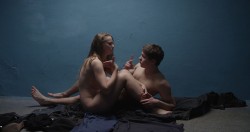Cinema | April 15th, 2015

Myroslav Slaboshpytskiy engineers a jaw-dropping feature debut in “The Tribe,” a stylistic tour de force that juxtaposes the gorgeousness of cinematic execution against the horror of the narrative’s unrelentingly grim subject matter.
Set in a Ukrainian boarding school for the deaf, “The Tribe” follows new student Sergey (Grygoriy Fesenko) as he receives an education in the institution’s real subjects: theft, assault, prostitution, exploitation and murder. Unbroken, shot-in-depth images of grisly mayhem unfold in real time, drawing comparisons to Gaspar Noe’s “Irreversible.”
The extent of the transgression, as witnessed at the screening I attended, can leave some viewers reeling, some sobbing, some making for the exits and some stunned.
Captured on 35mm film in long takes by cinematographer/editor Valentyn Vasyanovych, “The Tribe” exploits its widescreen aspect ratio through carefully staged dioramas that blend the kinetic motion inherent to the movies with the theatrical curiosity of still and silent “tableaux vivants.” Slaboshpytskiy’s cast members are all deaf nonprofessionals, and the entirety of the interpersonal communication that unfolds on-screen is delivered in Ukrainian sign language with no subtitles.
The bold tactic has been praised widely by critics, although film critics Justin Chang, Peter Bradshaw and Steve Macfarlane all raise key questions. Macfarlane asks, “Would this choice not be offensive if applied to other languages? Is sign not, in 2015, a real language?”
Unquestionably, “The Tribe” is a film about the deaf, but it is made principally for what Raymond Luczak would describe as a “hearing community.” Slaboshpytskiy’s emphasis on sound design invites critique that the manner of the film’s subtitle-free presentation is, according to Luczak, audist – perpetuating the idea that an ability to hear makes one superior to those who cannot.
Luczak cites several concrete examples, including a shocking death by truck and the movie’s stomach-churning finale, challenging their plausibility and framing their inclusion as exploitative on the part of the writer/director.
Luczak’s detailed essay on “The Tribe” is the most thoughtful and thorough piece written on the film to date, providing a wealth of crucial context and important perspective. In addition to a compelling explanation of the film’s inherent audist/ableist biases, the review explores our conceptual relationship to the reception of silent cinema and the evolution of cinematic language, concluding that Slaboshpytskiy has unconvincingly conflated pantomime and sign language.
Given the filmmaker’s own comments in press materials quoted by Luczak, the accusation is real food for thought.
Luczak also attacks Slaboshpytskiy for what he describes as the “distance between the performers and the camera,” insisting that the application of the technique diminishes the film’s characters by stripping them of “emotional complexity.”
Emotional complexity and carefully maintained distance, however, might be more subjective than Luczak allows. Robert Bresson, Michael Haneke and Ulrich Seidl have been both lauded and castigated for films that defamiliarize, estrange and alienate via cinematic variations on several aspects of Brechtian Verfremdungseffekt that make room for alternative ways of reflection and engagement with performed content.
“The Tribe” depicts the development of a romantic/sexual relationship between Sergey and Anna (Yana Novikova), a fellow student forced into prostitution by the shadowy criminal organization that operates from within the boarding school.
Sergey’s desire for Anna collides with transactional realities that simultaneously point to fee-for-service intercourse and the possibility that enough money could represent a way out for the pair.
The movie’s signature promotional image, used in publicity stills and on the theatrical poster, shows Sergey and Anna unclothed. Slaboshpytskiy’s provocation has led to speculation that the nudity serves to remove some kind of communicative “barrier,” allowing viewers more intimate and immediate identification with the film’s ill-fated inhabitants.
“The Tribe” has screened at several film festivals and will be released theatrically and on-demand in the United States by Drafthouse Films later in 2015.
December 29th 2025
December 29th 2025
December 16th 2025
December 9th 2025
December 2nd 2025

_(1)_(1)_(1)__293px-wide.jpg)
_(1)_(1)_(1)__293px-wide.jpg)
_(1)__293px-wide.png)
__293px-wide.jpg)
_(1)__293px-wide.png)